Introduction
In 2008 I was living in London in a squat in Dalston, in the Colvestone Crescent just next to the Dalston market. The house was quite large, a three-story building with a fairly large garden, in sum, maybe around 250 sqm. The ground floor was damaged during a fire which, as it turned out later, took place when the building was squatted by another group of people a year before. On the first and third floor there were bedrooms which we usually shared between two or three people and on the second floor there was a large living room and kitchen. In total nine people lived in the building. Some of them were anarchists and activists involved in various local and international social affairs, the others were rather focused on painting and working in odd jobs. Our anarchist friends wanted to have their space to organise meetings where they could discuss different matters with activists from other squats, therefore, they arranged a space in one of the rooms in the burnt part of the building on the ground floor.
I was not involved personally in those meetings but what attracted my attention then were numerous posters and publications found in this room. They were often informative, announcing various manifestations, fundraisers for people in difficult life situations, due to political reasons, or organisations fighting for animal rights, etc. The typography was made by hand from newspaper clippings and illustrations drawn in a specific style that reminded me of punk magazines. They had simple form, very specific aesthetics, and the message was always clear and powerful – they called for action. At that time I wasn’t drawn to graphic design yet, but I remember that co-tenants often mentioned a provisional ‘print shop’ located in one of London’s squats where they produced those posters and publications. I was interested mostly because my father, who lives in Ukraine, has a small print shop and I saw him there many times printing various leaflets and booklets on his Riso machine.
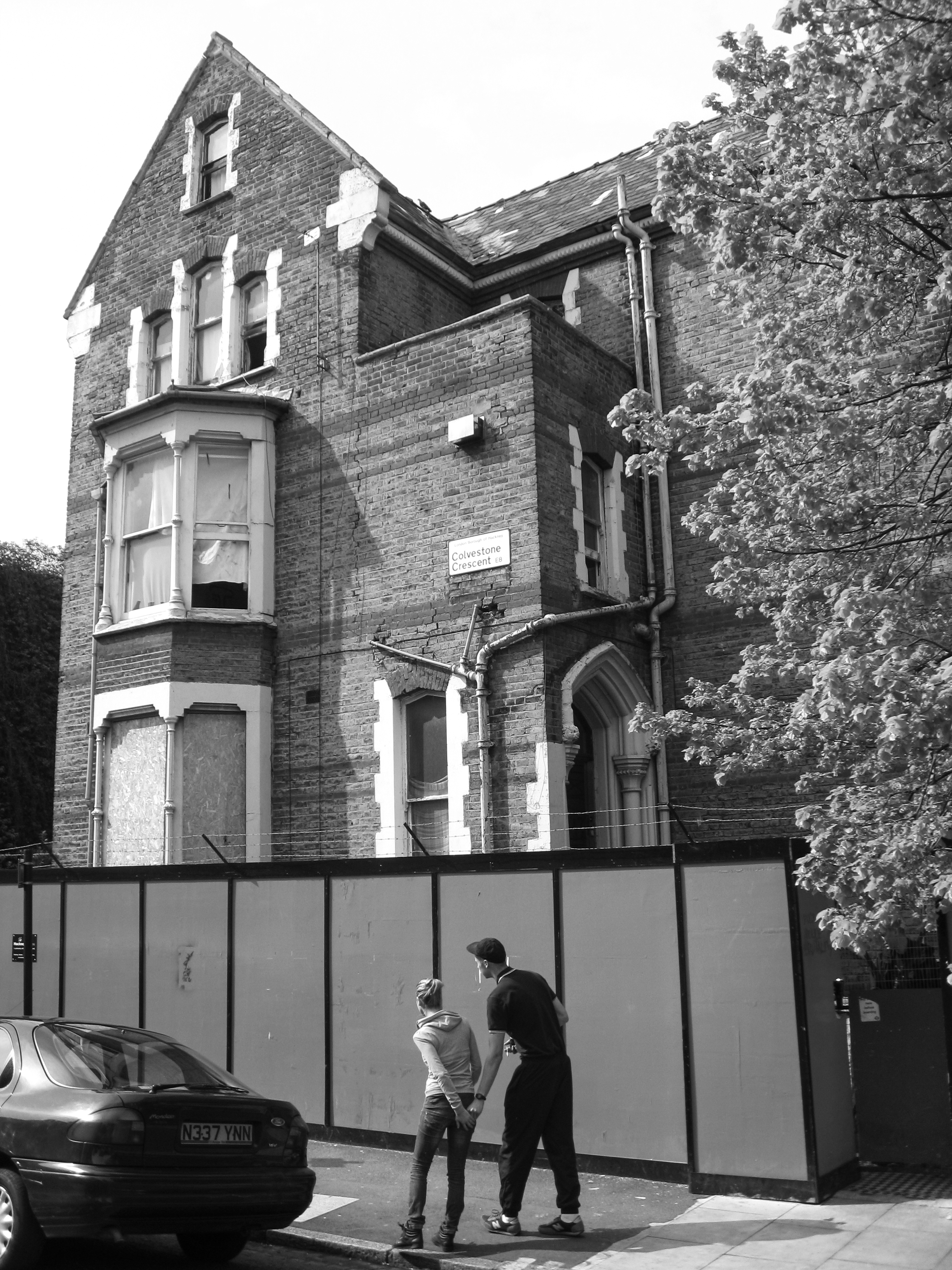
Occasionally the activists were bringing large blocks of posters wrapped in paper and leaving them in our living room. Sometimes, lying there for months, they served as temporary furniture like stools or tables. I liked the idea that someone is able to print such large quantities at their home in squat and produce a number of publications which were later distributed throughout the network of squats. The aesthetics of those works seemed familiar and brought back the memories of my childhood years when I was living in Drohobych, Ukraine and later in Warsaw, Poland, where my great grandfather had small publications with satiric illustrations in his apartment. It was only when I grew up that I understood that these were Polish underground counterpropaganda publications from the late 1980s – the voice of a society opposing the communist system. My father told me that there used to be more of them but our grandfather burned them down, afraid that they would be discovered during random intrusions pursued by the communist authorities. In the 1980s in Poland the possession of any of such materials could provoke an arrest, often for indefinite period of time, and interrogations. When living in London I have seen numerous flyers from VOTR (Voice of The Resistance) an organization and print house which published a large number of posters and booklets opposing animal testing and fur farms, articles opposing racist acts and announcing manifestations across European cities. Print seemed to be the main information carrier for readers of Front (publication run by VOTR). According to the editors on the Internet no one is anonymous and it is easy to be tracked down, while in case of printing only the moment of printing and distribution is traceable. I began to wonder if there are other places that are or used to be squats and still operate as print houses. An adequate example is the one derived from Dutch squatting movement from 1980’s - Rob Stolk, one of the main founders of Provo movement and Raddraaier. This cases help to understand the general role and consequence of private presses emerging at that time in Amsterdam and paved the way for their successors. Firstly it is important to define what the term ‘private press’ means. The main difference between public and private press is that the so called private press does not aim at financial profit and usually it has a counter position to some complex aspects of social and political issues. Its quantity is often limited and usually the typographer is involved in the entire production process which often takes place at home or in secret locations.


The Origins of private press
The term private press appeared at the turn of the 19th and 20th centuries under the influence of William Morris and Emery Walker, who considered the book and their productions as a work of art, and not only, as it was previously considered, a means of dissemination of information. Both men thought that printing, paper making and binding techniques were a very important part of the production process.1 At that time, a cheap mechanised production method dominated.
Morris and Walker believed that this was a problem and that they should return to the crafts and spiritual values of the Gothic period. In 1891, Morris founded the Kelmscott Press with the vision of producing a high-quality book using handmade paper, rich dense inks, often specially designed typefaces and the impressive ‘Improved Albion Press No. 6551, ’a hand press almost seven feet high, weighing over 2,000 pounds, made in 1891 by Hopkinson & Cope in England. It is worth highlighting that Morrison deliberately payed attention details such as page proportion with its margins, illustrations, typefaces and binding as books were mostly hand bounded. Morris himself was very much involved in social life in Britain and the world in the late nineteenth century. In fact, his Kelmscott Press was a form of protest against capitalism and mass production and exploitation of employees.2 Before founding the press in 1884, he founded SL (Social League) whose main idea was to oppose “Commercial War” (description of capitalism in the words of Morris).3 At that time he met on many occasions with representatives of left wing parties like SDF (social Democratic Federation) and NLL (far left National Liberal League) with which help, for example by calling activists to take action and block the elections, he hoped to create socialist society.
By publishing his texts in the Commonweal (the journal of the socialist League), Morris not only had a platform to disseminate his idea, but also to implicate them already in the form of the production in which they were presented. In journal he started experimenting with alternative print media and graphic forms. While working at Kelmscott Morris continued to pursue his ideas regarding capitalism and mass production through the way all printed matter was produced at his press. Not only he commissioned typefaces and used his own type (Golden) but also hired Walter Crane for illustrations to the texts. To draw an example of Morris dedication “The Story of the Glittering Plain” was first published in 1890 in Commonwealth but unsatisfied Morris wanted to reprint it and publish a decorative edition which he succeed to do so in year later in 1891 at Kelmscott. This shows how crucial it was for him to show the work of a typographer and all content in the form of artistic expression. Continuing this vision in Kelmscott, Morris sometimes got into minor conflicts with Crane because he was not always satisfied with his illustrations.

In “The Story of the Glittering Plain”, he was irritated by the inconsistency in Crane’s illustrations and for some time “told Crane that he thought woodcuts looked” delightful “in the final edition” he really was far less pleased with them as he said in letters to his friend.4 The printing house only operated for 7 years managing to produce around 18,000 copies of 50 different works.5 The establishment of Kelmscott Press inspired the creation of other private press in England at that time like T. J. Cobden-Sanderson at the Doves Press, Pear Tree Press, the Gregynog Press, and the Golden Cockerel Press which were also very successful. The Kelmscott Press lasted only seven years, but it spawned an international movement that continues today. Already in the beginning of 1900’s we can observe appearance of small, often illegal press. Those were important for the places because the works they printed had a great influence on what was happening in society. It is important to mention that in the beginning of 20th century States had enormous respect for written word that they were tried to have printed matter under perpetual surveillance. However in 1900’s Tsar Nicholas II wasn’t aware that in some places of his empire were illegal printing presses which were spreading not tilting tsarist views. One of those places was the printer in Baku (founded in 1901) and Tbilisi’s (founded in 1904) both were illegal printing press.
The printer in Tbilisi was publishing in the following languages, Georgian Russian and Armenian, mostly pamphlets, leaflets and newspapers. The printing house was located on Avlabari Street in Tbilisi. From the outside, it looked and still look like a normal family home. The architecture had to allow for a secret printing house to operate, before the construction of the building, Mr Mikheil Bochoridze responsible for the construction and Mr Rostomashvili, the landowner planned the construction of ventilation tunnels (it took two years to build them) that provided the secret rooms of the secret printing place with oxygen.6 Back then 24-year-old Stalin began living in the building immediately after its construction in 1904, where he immediately started writing articles that he later published himself in the basement in the Brdzola (The Struggle) newspaper. The first issue of Bzdzola was published in September 1901. Uncensored, with militant tone, newspaper contained correspondence from workers, chronicles strikes In Caucasia and Russia, poems dedicated to workers struggle and reported activities of the RSDLP (Russian Social Democratic Labour Party). It called for political agitation and street demonstrations calling for political action - “street demonstrations where workers can powerfully unite.”7 The cover for print house was two women who were usually sitting on the porch knitting.

Their role was to alert the printers if someone suspicious was coming to close – they had to push a button (alarm) once; they pushed it again to signal a false alarm. If they pushed it three times, it meant it was time to hide!8 The bell signal was connected to a basement 15 meters underground. A German printing press that dates back 1893 was first dismantled, then smuggled and reassembled piece by piece in the cellar. The access to the room was inside the well, on one side there was a corridor that lead to a secret room. Tsarska policka (Tsar’s police) found a trail of couriers, which led them to the illegal press which caused the raid in 1906.9 The police have already suspected that place for some time and decided to inspect the building. They decided to throw the matchstick into the well when it turned out that there was a gust of wind blowing it into a side tunnel showing the secret passage of the store led to the basement.
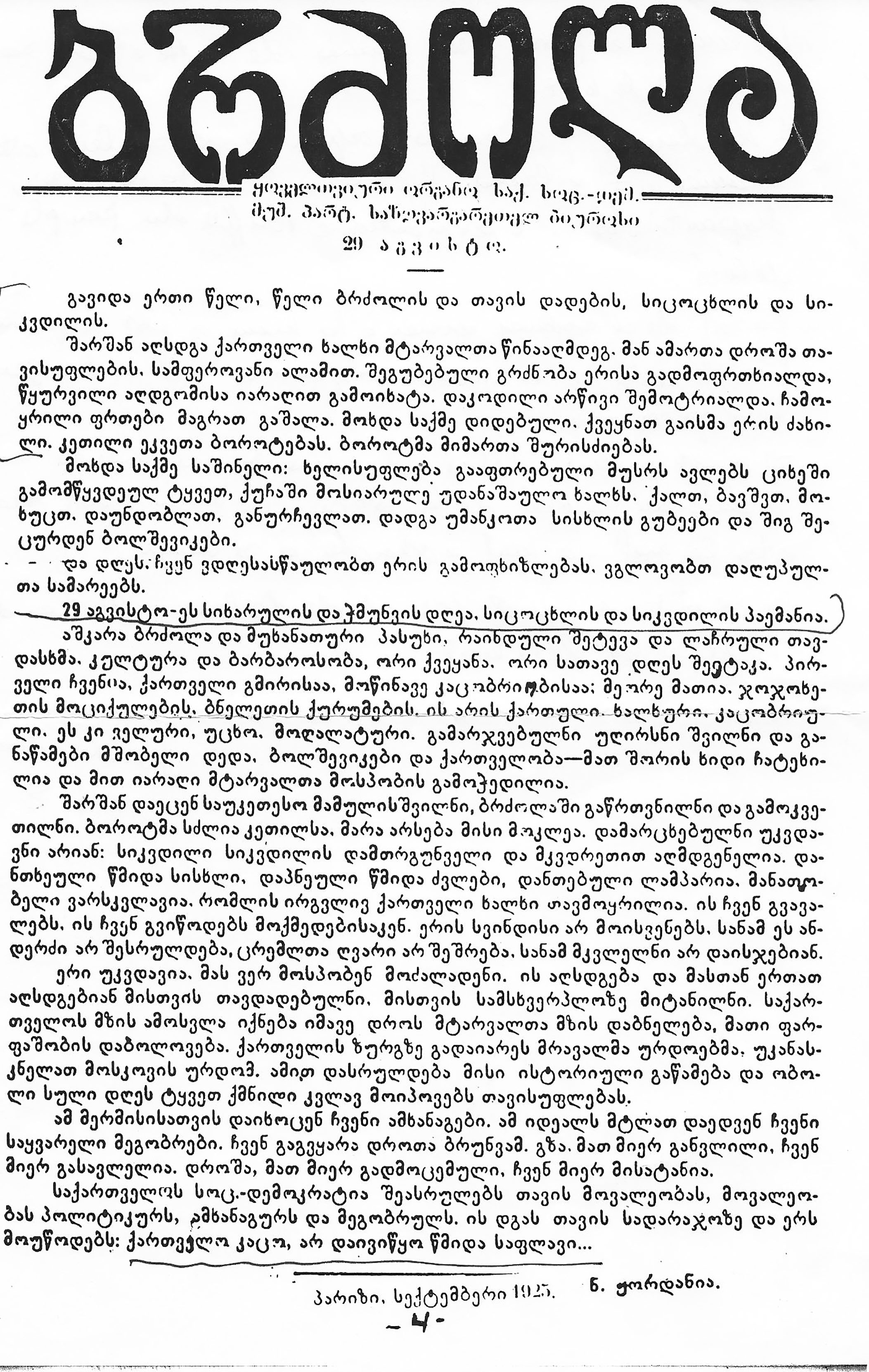
Morris and Stalin were both compulsive readers, devoted to books. With the help of their private presses, they were able to demonstrate the method of objection to some aspects of life at that time, helping them to spread their ideas and vision through their own press. In the case of Kelmscott, apart from the written word, an important aspect was also the artistic value, which was also a form of protest to the industrial revolution and its consequences in the manner and quality of book printing. All books published in Kelmscott still amaze today and their value today manifests itself as a symbol of counter position of Morris press and its quality. In the case of Brdzola newspaper, the whole world was able to witness the result of articles written in it which to a significant extent, influenced the revolutions in Russia which started with the abolishment of monarchy in 1917.
Printing as form of resistance
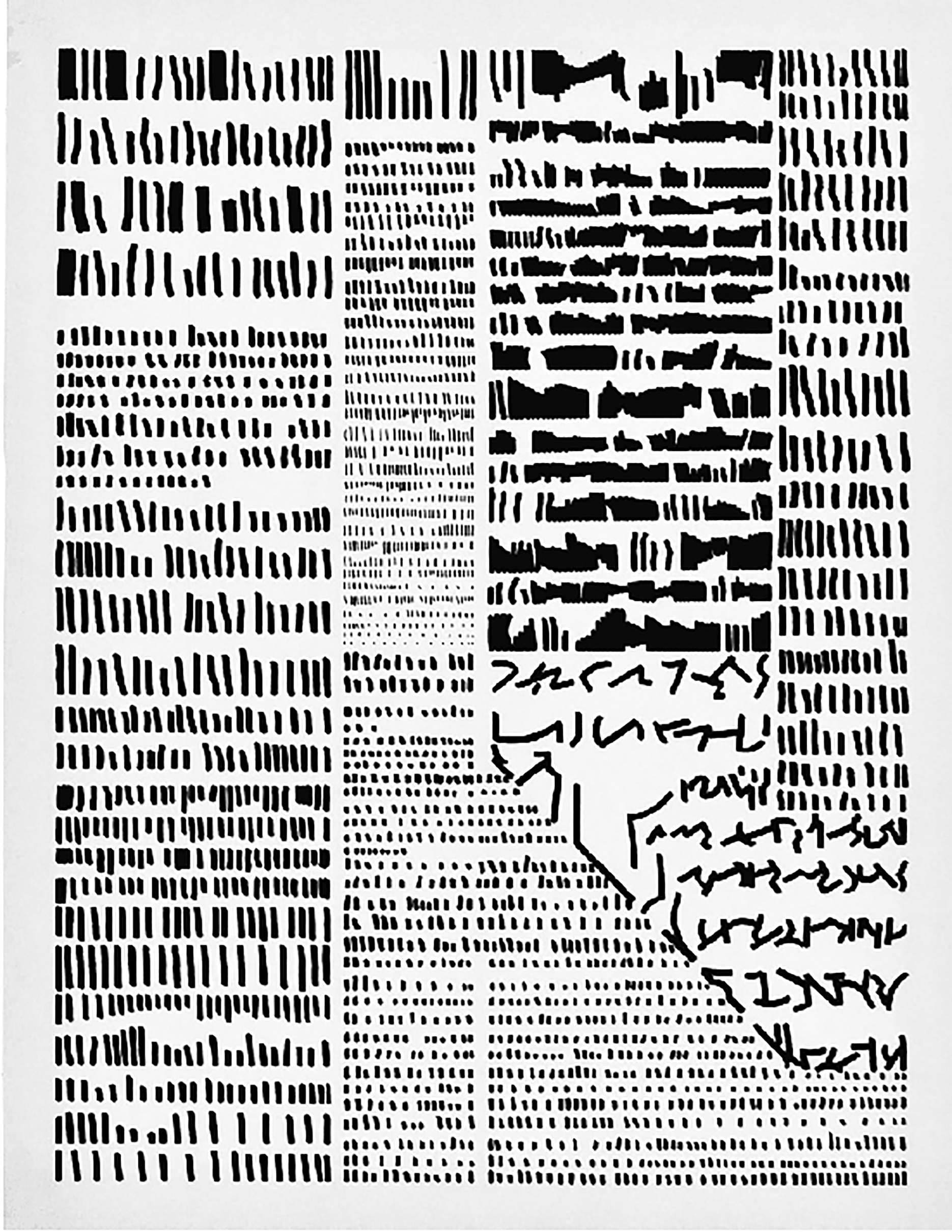
Looking closer at the impact on society and the history of the functioning of the William Morris Kelmscott press and the printing house in Tbilisi, one can easily see that a similar feature connects them (in my opinion and other private presses around the world). Usually it’s a counter position to the political system and some aspect of social life expressed by printed matter. A few days before writing this chapter I met with the English book collector Louisa Riley-Smith who showed me the work of the Argentinian artist Mirtha Dermisache (1940-2012), titled Dario No 1. In this work Dermisache copied the format of the daily newspaper, however the information contained in it is in the form of illegible characters of different forms. Seemingly it looks like a classic newspaper, however, it does not fulfil its informational form and we will learn nothing from the newspaper. This is the artist’s response to the content that could be found in newspapers in Argentina in the 1970s, which were under strict censorship control and rather no real information could be found in the newspaper. The artist’s design reflects the same essence through the form of illegible characters.
While looking at Dario No1, I immediately could feel the connection with the underground press from Poland from the 1980’s. At that time TV news and all printed matter in the country were under strict censorship. Quite literally no real information could be found in the Polish media at that time. Hence, people started printing various types of brochures and newspapers in their homes to inform each other about what was happening in their cities, workplaces and planned manifestations. On 13 of December 1981 martial law was introduced in Poland.
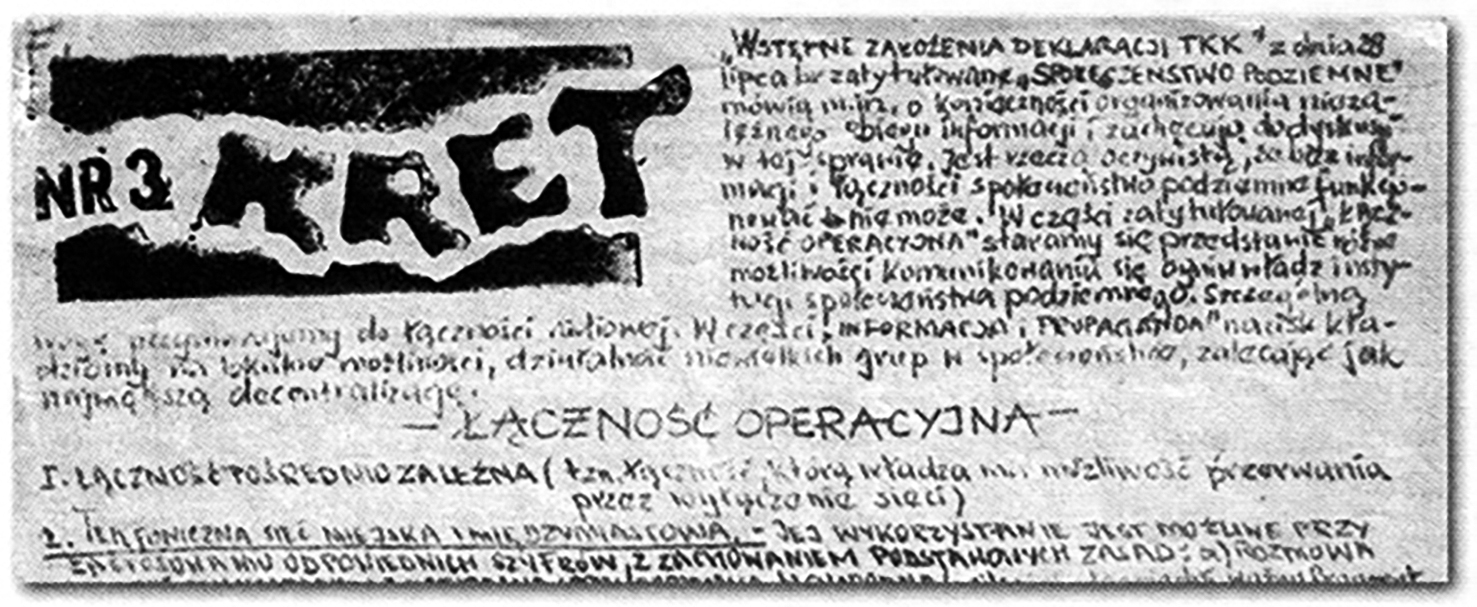

The Polish government was under strong Russian communist influence and 1980 people started a mass resistant movement by organiszng a lot of protests against the government which resulted in massive riots. NSZZ Solidarność (The Independent Self-Governing Trade Union “Solidarity”) which was formed after massive strikes and following agreement with the communist government in August 1980. On 10 November 1980, the NSZZ Solidarność was registered and just two days after General Wojciech Jaruzelski decided to start martial law. The Russian army was waiting next to the Polish border for order to enter Poland and help to resolve protests with additional tanks and soldiers. On 13 December, right after introducing a martial law the Polish communist government started the operation named “Jodła”, the purpose of which was to detain all NSZZ Solidarity activists (It was described as: “selected persons recognized as dangerous to the security of the state…”), and place them in previously prepared arrests and prisons and operation “Azalia” aimed at disabling tele-transmission facilities and telephone exchanges.10 The phenomenon of artistic creativity in this hard time also appear in such difficult conditions as the internment camps. Songs, poems, stamps of the mail of interment post (which was often smuggled), books and small publications which specialized in increasing the knowledge of internees in such practical topics as schematics and construction of radio stations or printing methods in prison conditions. One of those magazines was Kret.11 Printed and then distributed from camp at Uherce Mineralne - a small village located in southern Poland. In this publication we could find a detailed description of how to make underground press.
The description contains information about checking the source of information, the criterion for the selection of material for the magazine and its purpose, financial matters, the basis of conspiracy, printing techniques and their capabilities and distribution. In the part about material selection authors emphasise that the content of information in a given press should be devoted to its own field, announcing messages and statements of underground authorities as well as important national events. An important element is also giving who publishes, where and date, without providing names and addresses. The graphic design aspect was also mentioned as important ingredient. We could read - “When there is space, do not use “fillers” - it is better to include a satirical drawing...It is not allowed to divide larger articles into parts - it is better to make journalistic additions (this gives the possibility of reprinting from other magazines). In an emergency, an extraordinary edition may be used. Remember to reach bulletins for people with extensive contacts.”12
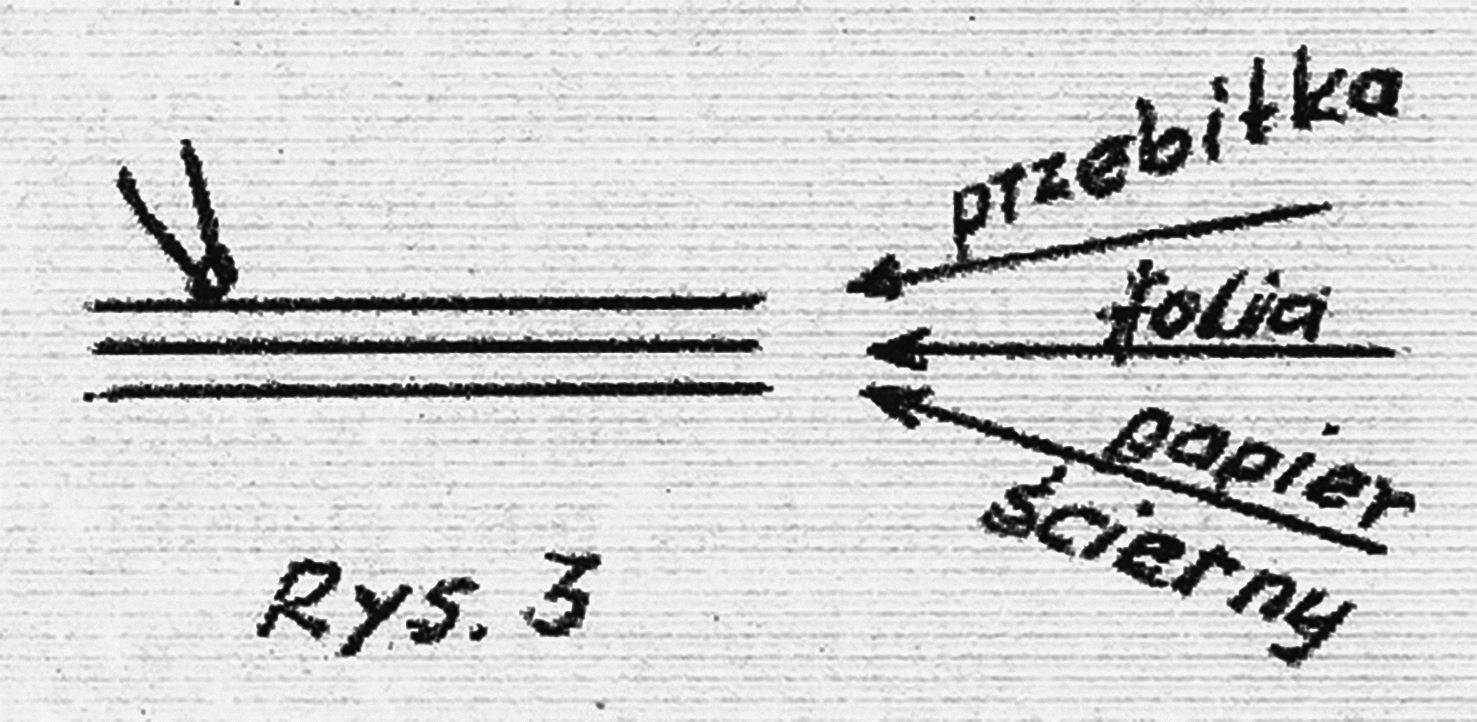
In order to finance all process of production, the editorial office recommends collecting money in its own circle as well as creating permanent subscription system. For security reasons, the team advises on absolute separation of the editorial office from printers and distributors. This separation was crucial as it was making harder for secret service at that time (SB) to track down the source. Description goes as follow: ”A few editors prepare the appropriate number of matrices. Two-person printers print one thousand copies so that ten main distributors receive no more than 100 copies. Each main distributor distributes 10 copies to direct distributors. In the opposite direction, paper and money are collected.” The person responsible for printing in Uherka Mineralne magazines “Kret”, “Zadyma bieszczadzka” and “Skrót” was Andrzej Perlak.13 He gives in the third issue of “Kret” a detailed description of how it was printed in order to of course disseminate instructions on how to construct the press yourself. The materials need for printer were glass (later replaced by PVC plate), a set of separate letters, photographic roller, sandpaper and food wrap foil. Kret was published in print run of 150-200 copies which was quite an achievement considering it was published in the camp.14 In addition to publications, one of the better known fields of internees work was creating stamps and rubber stamps. Every suitable material and object was used to create them: drawing erasers, linoleum from the floor, soles for shoes. They were engraved with a razor blade, a penknife, a stylus made of tinned metal, handle made of plastic parts for pens. Printing ink was most often obtained from blown pen ink, but also from iodine and black shoe polish. If someone succeeded to smuggle original printing ink (sometime workers of redress were helping with that), then quality of prints was much higher. The inspiration for Internment post were Pow (prisoner of war) camps posts. During the martial law internment post was illegal and any work at that time found in the camps would be requisitioned and anyone involved in it would get punished. The whole effort that prisoners put into printing, smuggling information and the ability to communicate through underground to resist than communist government.
Inbound and outbound shipments were subject to martial law censorship (carried out at post offices), were read by SB (security service) and prison service.15 Letters and all parcel were always opened by them so Internment post was an alternative solution to be able to communicate with other camps and outside world. Rubber stamps often stated - “uncensored” and served as verification of the authenticity of letters and leaflets broadcasted from the camps to the external world and vice versa. Secret circles of production like this very actually not first in history of Poland. Releases without censorship were defined differently. The longest, because over a hundred years old pedigree has the term “Bibuła” (pol. tissue paper). It originated from the name of thin paper, on which publishing houses were printed, imported in the second half of the 19th century to the Russian partition, without the permission of tsarist censorship.16 “Bibula” has become a weapon in the fight against the oppression from the countries occupying Poland. Also during the Second World War underground press (or any schools financed by the underground government) were part of movements aimed at releasing the state from oppression.

The censorship in Poland was created immediately after World War II on July 5, 1946 by the head of the security department Stanisław Radkiewicz. The tasks of the office included the supervision of the press and the dissemination of all kinds of images and words written by means of printed matter. Censorship was preventive, which meant that materials had to be approved by the censorship officer before publication and dissemination. In practice, there was no appeal against his decision. Underground press had to obey the rules of conspiracy, because for printing the publication without the consent of the authorities severe penalties were imposed.
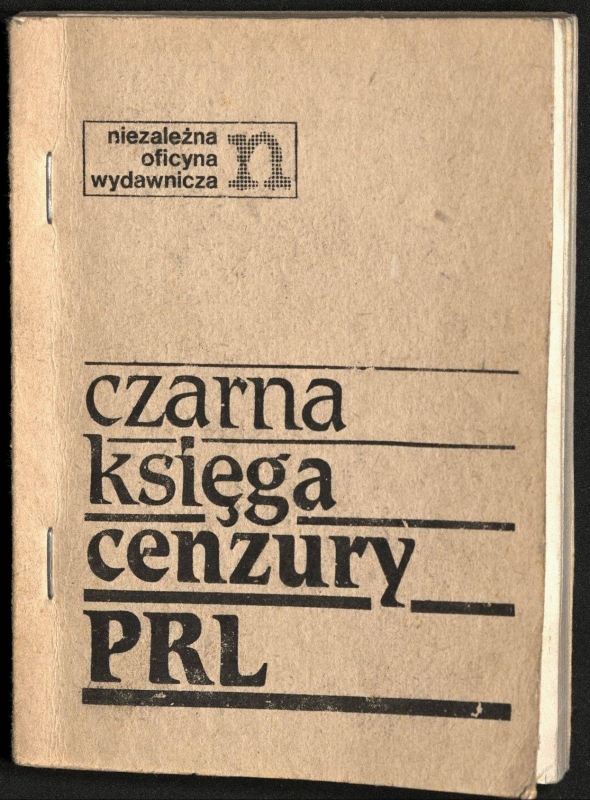
In 1977, Tomasz Strzyżewski, an employee of the Krakow delegation of the censorship office, secretly took over 700 pages of handwritten censorship entries and recommendations found in the Book of Entries and Recommendations of the GUKPPiW (Central Office for Control of Press, Publications and Performances) to Sweden.17 During his stay in Sweden, Strzyżewski sent entries from the book to the deputy so that printers at the time had an understanding of the criteria and what they pay attention to in the censorship office. In the 1980s, the situation was not as dramatic as during the war, nevertheless, the oppression of the authorities led to a national strike. Production of publications outside of camps was taking place in people’s homes.
According to many opposition activists, creating an information-independent flow of information was one of the most important methods of fighting against the communist regime in Poland.18 The first issues of many first underground publications letters were typed; soon there were underground publishing houses with better printing technique. My grandfather (born in 1938) told me that people were afraid to typeset on the typewriter, as the neighbours might hear the sound of the fingers hitting the keys. You could never trust your neighbours as at that time undercover agents were trying to threaten as many people as they could in order to get any tiny bit of information about the underground press. Between 1976 and 1989, thousands of independent publications appeared, sometimes with two or three numbers each.19 The amount of printed matter emerging from underground presses shows the scale of resistance. The drive people in Poland had at that time to fight for they freedom shows also through the work of resistance in the internment camps. People were so desperate that with all cost just wanted to find for they freedom with all methods available. Making ink from pen or shoe polish only shows determination and stubbornness. To put it briefly, the resistance of the society was so great and showed such fierce determination that it led to the collapse of the communist system in Poland in 1989.
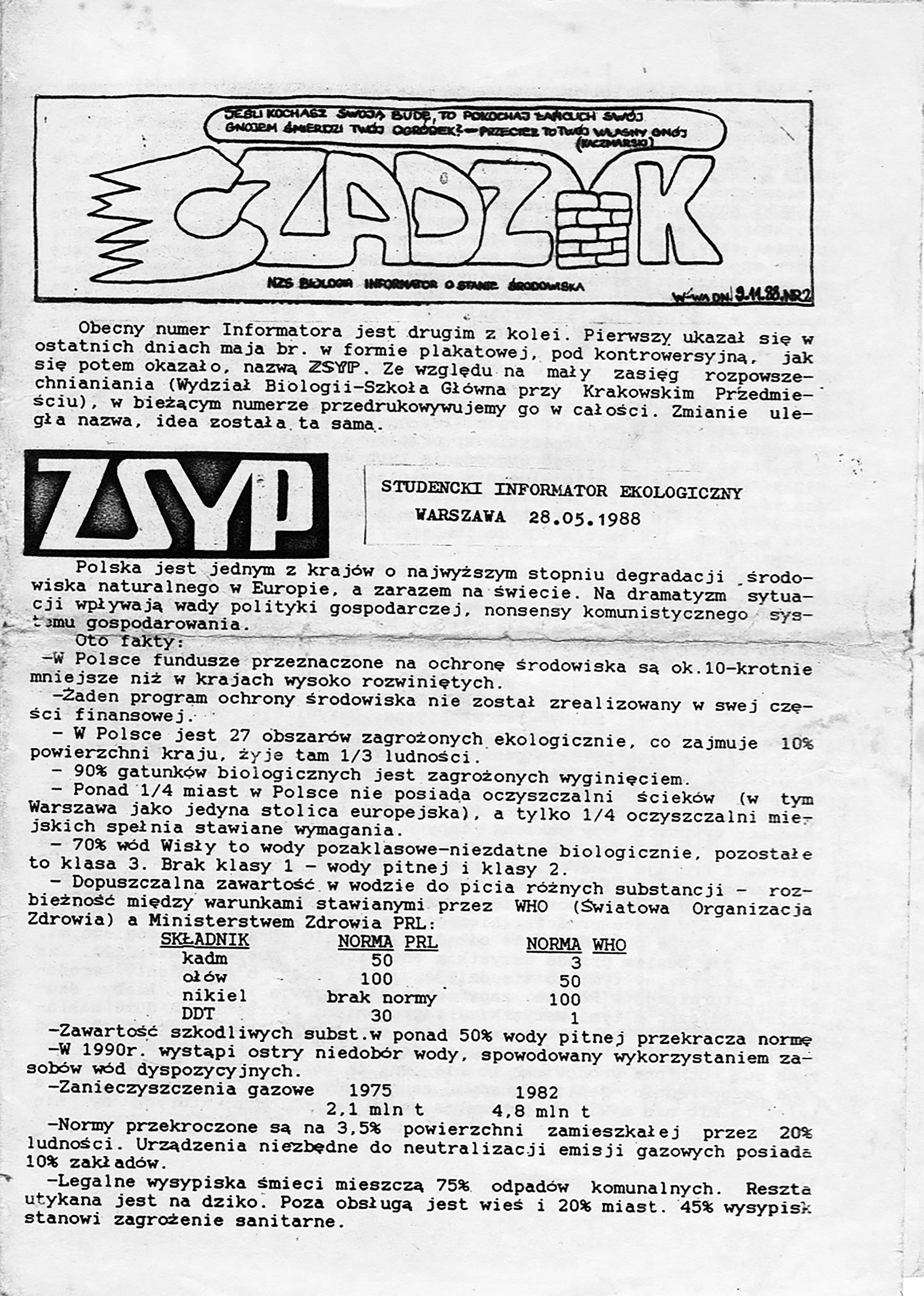
The impact of publications
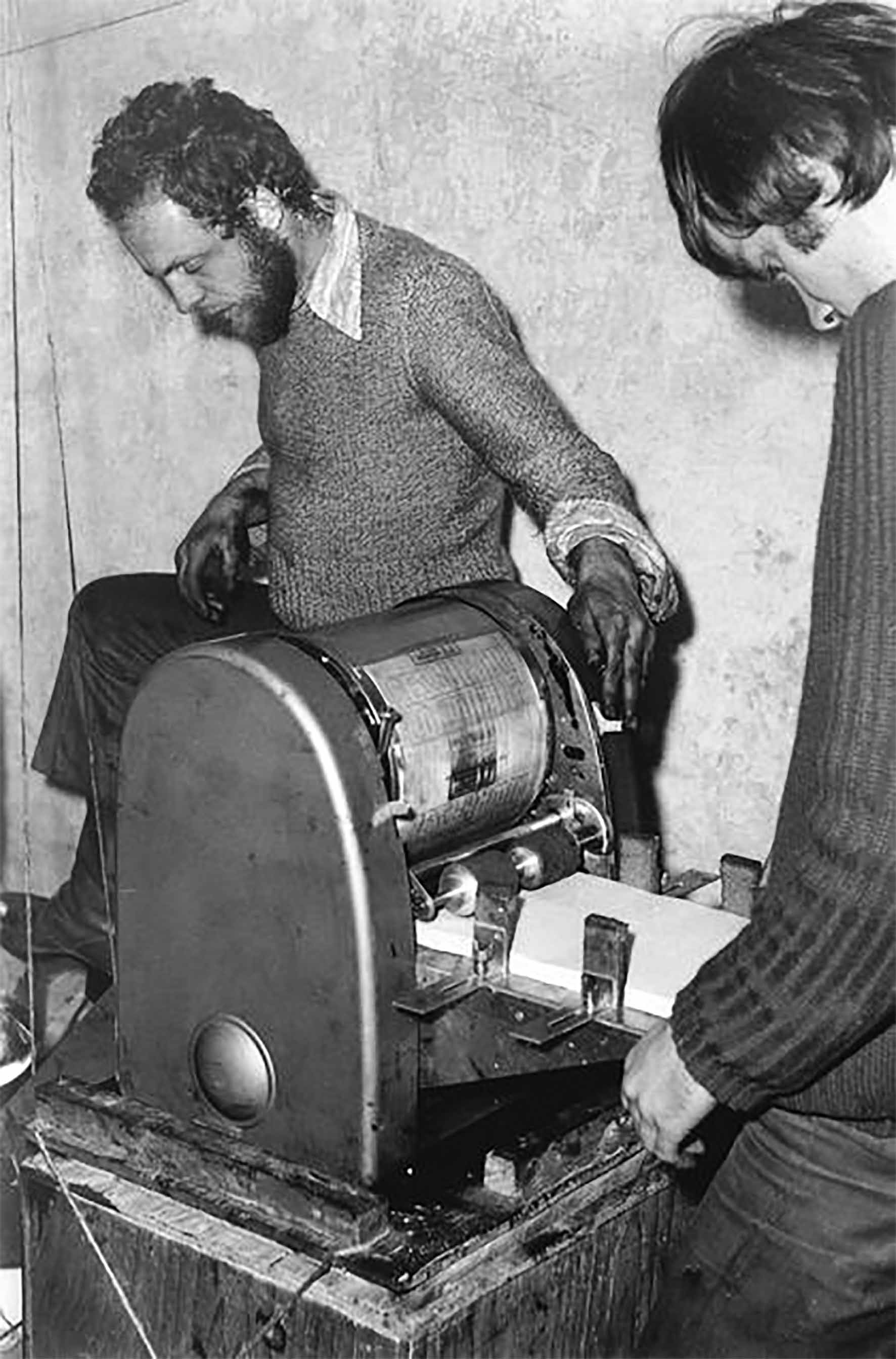
When describing the role and impact of resistance in Poland, it is worth paying attention to how the written word influences the realities of life in society. The French philosopher Régis Debra in his text on “Socialism: a life-cycle”, cites an example from Russia and the beginnings of socialism saying that “Socialism was born with a printers’ docket around its neck”.20
According to the French philosopher, the position of a typographer occurs between proletarian theory and the working-class condition. He treats printing as the quintessence of ‘worker intellectual or an intellectual worker’ which is an important part of socialism Bebra argues that in the 19th century typographers and intellectuals together with scholars were important elements at the beginning of the socialist movement. The change in mood in society in the working-class class was the tangible impact of printing and access to Libraries and newspapers. He describes an importance of printed matter in those words: “Writing collectivises individual memory; reading individualises collective memory. The back-and-forth between them fosters the sense for history by unearthing potentials within the present, creating backdrops and foregrounds; it is fundamental for the idea of socialism. When it is cold outside and the night is long, memory means that we are not alone. Alphabetical memory, as Hegel would put it. Contrasting ‘the inestimable educational value’ of learning to read and write with alphabetical characters, as opposed to hieroglyphics, he described how the very process of alphabetical writing helps to turn the mind’s attention from immediate ideas and sense impressions to ‘the more formal structure of the word and its abstract components’, in a way that ‘gives stability and independence to the interior realm of mental life.” Humans move between ideas that shape our reality.
Focusing on a specific aspect of the emergence of the socialist movement (as well as capitalist) movement Debra draws attention to the fact that all revolutionary activists were compulsive readers, devoted to books. To emphasise the importance of printed matter, Debra gives another example: “The greatest modernisers inaugurate their career with a backward leap, and a renaissance proceeds through a return to the past, a recycling, and hence a revolution. Columbus discovered America in a library, through the perusal of arcane texts and cosmographies. The Ancien Régime in France was overthrown by admirers not of Montgolfier or Washington, but of Lycurgus and Cato. Chateaubriand and Hugo revolutionised literature by dint of Gothic ruins, Nietzsche vaulted over Jules Verne with the aid of the pre-Socratics, and Freud revisited Aeschylus. If news bulletins are the medium for history as spectacle, the archive is the medium for history as practice. The story of communism—as revolutionary utopia, not bureaucratic dictatorship—has been a tale of archivists and old papers. Communism was the bookish invention of Gracchus Babeuf, a specialist in feudal law, who extracted its central ideas from Rousseau, Mably and antique parchments. It flourished in the great storehouses of the written word. For Michelet: ‘My history of the French Revolution was born in the archives. I am writing it in this central depot’—the official records office. Men wove between texts, texts wove between men.” Regis writes about the importance and influence of the printer on the development of socialism. Typesetter and printers become separate from publisher and author.
In general view, the role of one was to work with machines and the other with ideas.21 An interesting example of where is overlap is Detroit printing Co-op which communicates both informations about print shop and its idea. Other aspect which I think is worth mentioning is that some of the people involved in Co-op were activists involved in political movements. American author Danielle Aubert writes in her book The Detroit Printing Co-op - “Radicalised students were dropping out of college and moving to working class manufacturing cities where they saw possibility for enacting system change.” Co-op started to function in the fall of 1969 when a bunch of friends drove from Detroit to Chicago to buy a fifty year old Harris offset printing press. Freddy and Lorraine Perlman (two founding members of Co-op) , and their friends borrowed money for the printer and rent a space in the Southwestern area of Detroit. They treated their printer as a work tool, that anyone could use who was willing to learn to use it and who would help them operate in the printing house.
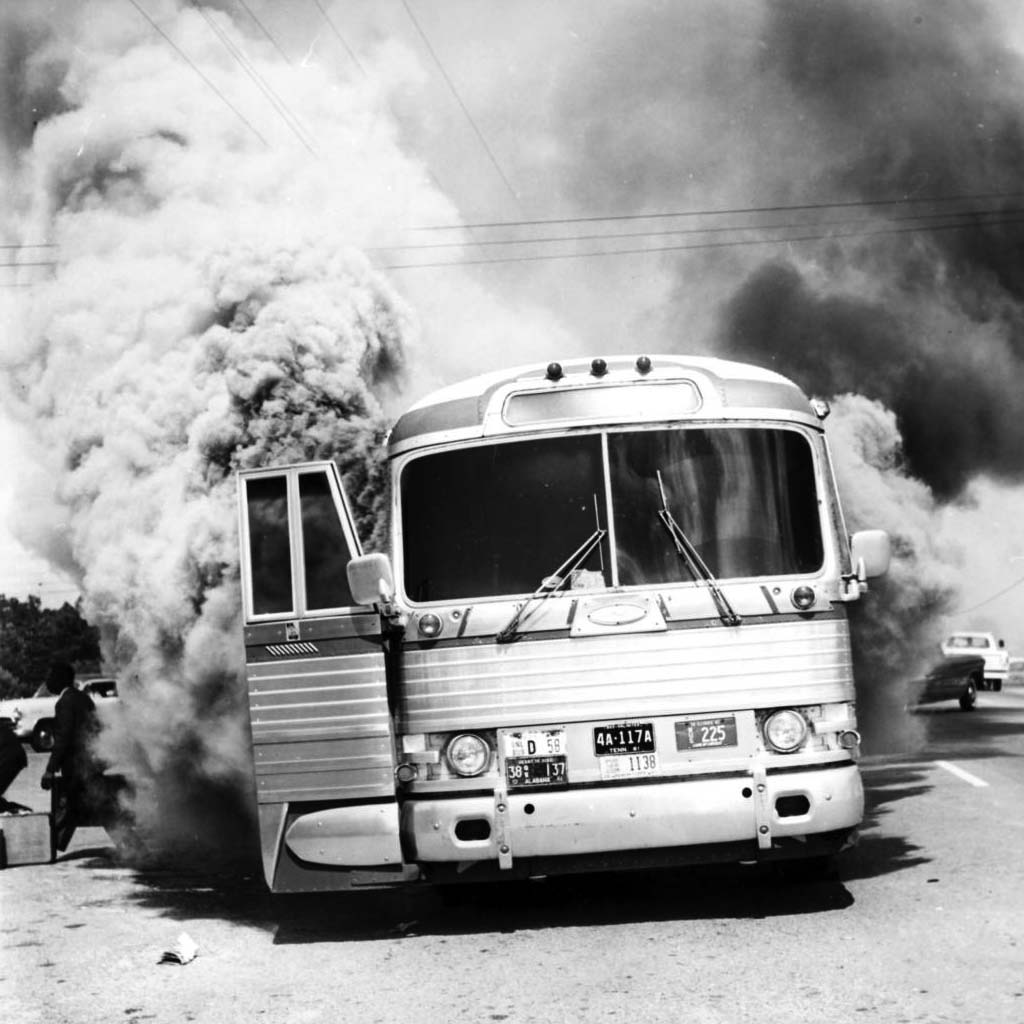
During their activities, they printed thousands of leaflets, publications and books. Many of these works had a great impact on what happened in America in those years. Printing and writing was a logical consequence of what was happening throughout the whole country, especially in the 1960s. There were great number of racial issues in America like segregation at schools and public transport or uneven treatment of black workers. This caused a lot of protest and many times violet acts all over a country.As an example, I would like to cite “Freedom Riders”. In the 1960 Supreme Court in Boynton v. Virginia declared that segregation of interstate transportation facilities is unconstitutional.22 CORE (The Congress of Racial Equality- African-American civil right organisation founded in 1942) organised first “Freedom Ride” to test a new law. Seven African Americans and six whites were placed in Greyhound bus in Washington, D.C. embarking on a tour of South America as a form of protest against segregated bus stations. When bus reached Anniston, Alabama bus was attacked by mob who threw a bomb into the bus. Freedom riders managed to get off the bus, but the aggressors started to catch them out in the street and brutally beat them. U. S. Attorney General Robert F. Kennedy (brother to President John F. Kennedy) negotiated with Alabama Governor John Patterson to find a new driver so that the journey can continue. During further way, Freedom Riders were attacked several times and when they reached Jackson in conch, Mississippi were arrested for trespassing in a “white-only” facility and sentenced to three days in prison.
This incident, including others at that time, provoked further demonstrations and speeches (like March on Washington with the famous speech of Martin Luther King Jr. “I have a dream”) in the calm of the country. In the 1960’s, Detroit was no different and many workers were resisting exploitation by their employers and also unions which according to the rules should protect employees. There were also many racial inconveniences at Unions so to resist union leadership, some of the revolutionaries, black radicals and intellectuals in the city formed the League of Revolutionary Black Workers in 1969. The league expanded their activities from organising meetings in factories to developing “revolutionary political consciousness among all black people”, admonishing that black workers are a key element in the economy of the United States.23 They were publishing they articles in Black-run newspaper Inner-City Voice. Dan Georgakas and Marvin Surkin’s in their Urban revolution studies “Detroit: I do mind Dying” mention cases when the FBI visited them in the office and accused of directly influencing rebellion formation.24 The printers cooperating with ICV at the time refused them further cooperation (also because of the FBI visits) in connection with which the editors had to look for new places to publish. They could never print twice in the same place, and to the addition “typographer’s union” voted that no printers would work with them, preventing subsequent issues. Georgakas and Surkin’s said: “Assuming control of the means of production essentially means that you are at the first stage of assuming stage power.” Inner-City Voice employees decided to put together their own printing company called Black Star.

They also added to the purchase of machinery at the Detroit Printing Co-op. Carl Smith (League of Revolutionary Black Workers member) helped to prepare a plan for a publishing house which operated as Black star Publishing where Helen Jones was a lead printer.25 However, the printing house did not achieve full potential and the journal “Radical America” printed at Co-op proved to be more successful in disseminating information. Journal was founded by activist Paul Buhle (member of Students for a Democratic Society) in 1967. It was first printed in Somerville, Massachusetts but after April 1970 all production was moved to Detroit where Jim O’Brien was a primary editor. Journal provided steady income which helped maintain Co-op by covering rent and repaying debts which they took on to set up the print shop. Lorraine Perlman mentions, “Printing an issue of Radical America was a labor-intense activity; it usually took about two weeks. Fredy and I were responsible for the dark room work, printing and folding. Many others came to help with the collating, binding and mailing.”26 Journal get consistent structure after 1973 when Marcia Salo Rozzi designed a cover for issue on woman’s labor. Rozzi introduced a system for typographic arrangements for a title set in Black Goudy typeface, and thick lorded square around an image. In its content Radical American focused on racists issues in the country, women’s liberation and working class radicalism. It was a platform were members of the league could use to express their thoughts. This work as some that were printed at Black star at the time like “Political thoughts of James Forman” by James Forman had a great impact on what was happening in those years in the American society. They were key independent information carriers that were shaping new awareness.
Cases: Provo and Raadraaier
"Freedom of the press is for those who own one."27 More examples of private press initiatives were observed in the world in the 1970’s. Squatting scene was emerging in Europe as a consequence of recession in the 1960’s. In different parts of the world starting from 1960’s squatting movement started to emerge especially in Europe. The American-Italian scholar Silvia Federici in her book “Feminism and the Politics of the Commons” explains that “…Squatting provides shelter in the absence of property ownership, and in this sense is generally understood as an act of commoning. “Commoning is a process by which the activities that sustain life, or reproductive tasks, are collectively organized outside the wage relation. This could be subsistence farming, collective cooking or childcare, or any organization of productive work in which self-sufficiency is cultivated against capitalist model of labor.”28 In Holland squatting movements were a direct result of the housing crisis. In 1960’s a lot of activists started to pay attention to the abandoned and uninhabited houses. City Council was planning to demolish empty buildings and replace them with new and therefor more expensive houses. A lot of people couldn’t find accommodation and started to occupy this properties and as plans of rebuilding whole neighbourhoods mainly because council planned to build new metro line through Nieuwmarkt, squatters tried to resist it by organising protest which led to big riots in 1975. Many of the buildings in the Nieuwmarkt were habitable by squatters.29
Important roles in influencing residents of Nieuwmarkt as well as all of Amsterdam had publications printed by Provo. Provo was a Dutch counterculture, protest movement which was known for its provocative actions in the public space. Those action were directed against the prevailing values imposed by authorities. Rob Stolk was one of the founders of Provo (together with Roel van Duijn, Luud Schimmelpennink and Hans Metz) who played an important role in the movement as a printer. Rob learned the great impact of the written word on his own skin in 1968 when he was arrested and imprisoned for six weeks for publishing a letter commenting on subject of city development.30 Immediately after leaving prison he started Woningburo De Kraker (“Housing Agency of The Squatters) with couple close friends and published Krakershandleiding an 14 page A4 manual of instruction how to squat with silkscreen cover. Slogan on the cover “Redt un pandje, bezet un pandje” (Save a space, occupy a space) was a direct link between Provo and squatting movement. At that time there were already many squatters in Amsterdam only nobody was calling them under that name yet. City was planning to demolish a lot of building in order to build subway line, highway and office buildings. The only way to stop it was to make people who cared about the area to collaborate with each other and take action. With this publication editors tried to change the passive situation. Publication had a valuable list of empty houses and tried to put squatting in more political context. It was a defense system against city council and mainstream media who were of course saying opposite. Another example of direct connection of Provo and city of Amsterdam appeared already earlier with the first Provo publication. Brick wall as a cover and name of magazine written by felt-tip marker, as direct connection of usage of graffiti on the walls at that time. All Provo posters and pamphlets were at the streets and walls of Amsterdam buildings and those walls also appear on printed matter as a direct link between city and printing press. In one of an early interviews one of Provo members commented on the cover “the wall everybody will bang their head against, sooner or later”.31

The main drive for Rob Stolk to set up his own private press was due to the fact that mainstream printing offices did not want to print Provo’s controversial and sometimes illegal material. The first issue of magazine was mimeographed in an edition of 500 copies, where 100 copies were distributed and the rest was confiscated by police because of article “on how to manufacture a bomb, a 19th century nonsense article that came illustrated with a glued-in firecracker.”32 Rob Stolk described printing process: At certain point, we started relocating our stencil machine. We had so much trouble with pamphlets being confiscated, because of insults to the queen and pranks like that - we just had to keep on moving the machine. One time, we were printing an issue of Provo in a tiny room in the Staatsliedenbuurt, in the house of a lady who had no idea what the magazine was about, but she assumed it was alright since her son was involved. I was constantly dragging suitcases and piles of paper around, nobody knew the location of the machine but me.33 Later in interview Stolk describes that he bought offset printer and installed it in secret location in the basement of small travel agency at Bloemstraat in Amsterdam.
After riots in 1965 during the wedding procession of Princess Beatrix and Claus von Amsberg, all members of printer were arrested. Police was looking for a press and wanted to confiscate it, but were not able to find it. This shows that city authorities were aware of big influence of Provo publications. The design of Provo magazines went against the commercial design of mainstream printed culture. To set up a text Provo’s were using typewriter, typography was set in other context then in mainstream publications and for me it was a beauty of it. Money was another restriction and the main point was to produce it as cheap as possible and to distribute it as wide as possible. In same interview Rob Stolk added: It just wasn’t organized well enough to sustain. That’s typical though for political projects: the distribution is geared mainly to get the publication to as many people as possible, not to get money back.34 Provo was a voice that wasn’t there before. When Provo stopped ideas were still there and public sphere took notice. In a sense, it was also the beginning of this kind of voice in Amsterdam, which gave the possibility of the appearance of other publications mainly derived from squats as Bluf, Kraakkrant or NN. Another place which I contacted during the research was Raddraaier - an Amsterdam based printer which was squat since late 1970s, and still operates now as legalized squat. I wrote an email the same day asking if I could visit them and have a cup of coffee and to hear more about their history. A few days later I went there and met Cia Franssens who is the only person from the original Raddraaier team, who is still leaving and working there.
Cia showed me around. It is quite a large space divided into several rooms in which there are different printers. The largest room has an offset printer and next to it there are piles of different types of paper. Moving around the rooms I felt the atmosphere typical for squat, as a lot of things were handmade and even though it was organized I still felt somehow pleasant mess. The other rooms have the functions of an office where calls are received and direct conversations with clients are carried out. Cia led me to a room where there is a laser printer saying that we can talk but she must continue printing.
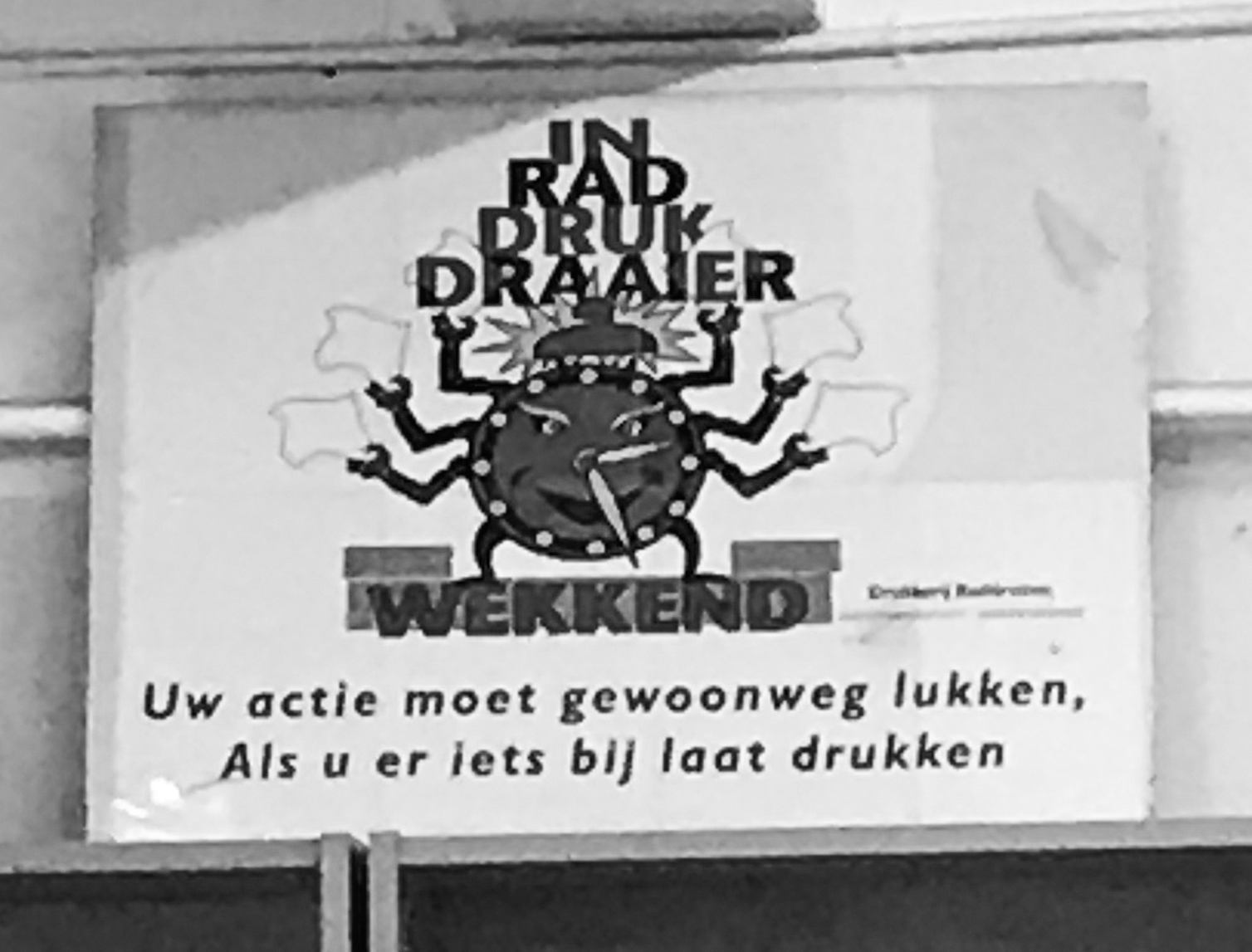
The beginnings of Raddraaier date back to 1978. The squat was then in another building and there was no offset and the whole structure of the printing house as it is now. Nevertheless, already then, wanting to express their opposition to the social policy in Holland, squatters decided to print booklets and flyers with they own views. In addition to the squatters printing house, they also organized a theatre, school and bicycle workshop there. They were strongly socially involved. In order to buy their first printer they borrow money from their friends and families. One of the first magazines that were printed from the early 1980s in Raddraaier was Kraaknewspaper and Bluf! They were platforms where they could freely publish their articles written by squatters mainly criticizing the state’s policy towards demolishing buildings and building expensive settlements in their place. To ensure the financial liquidity of the Bluf! The magazine was subscribed, had its own editorial team, illustrator and graphic designer. Not whole team from squat was involved in printing and those who were didn’t have a salary. Money earned during printing often went to help various people who need financial help.35
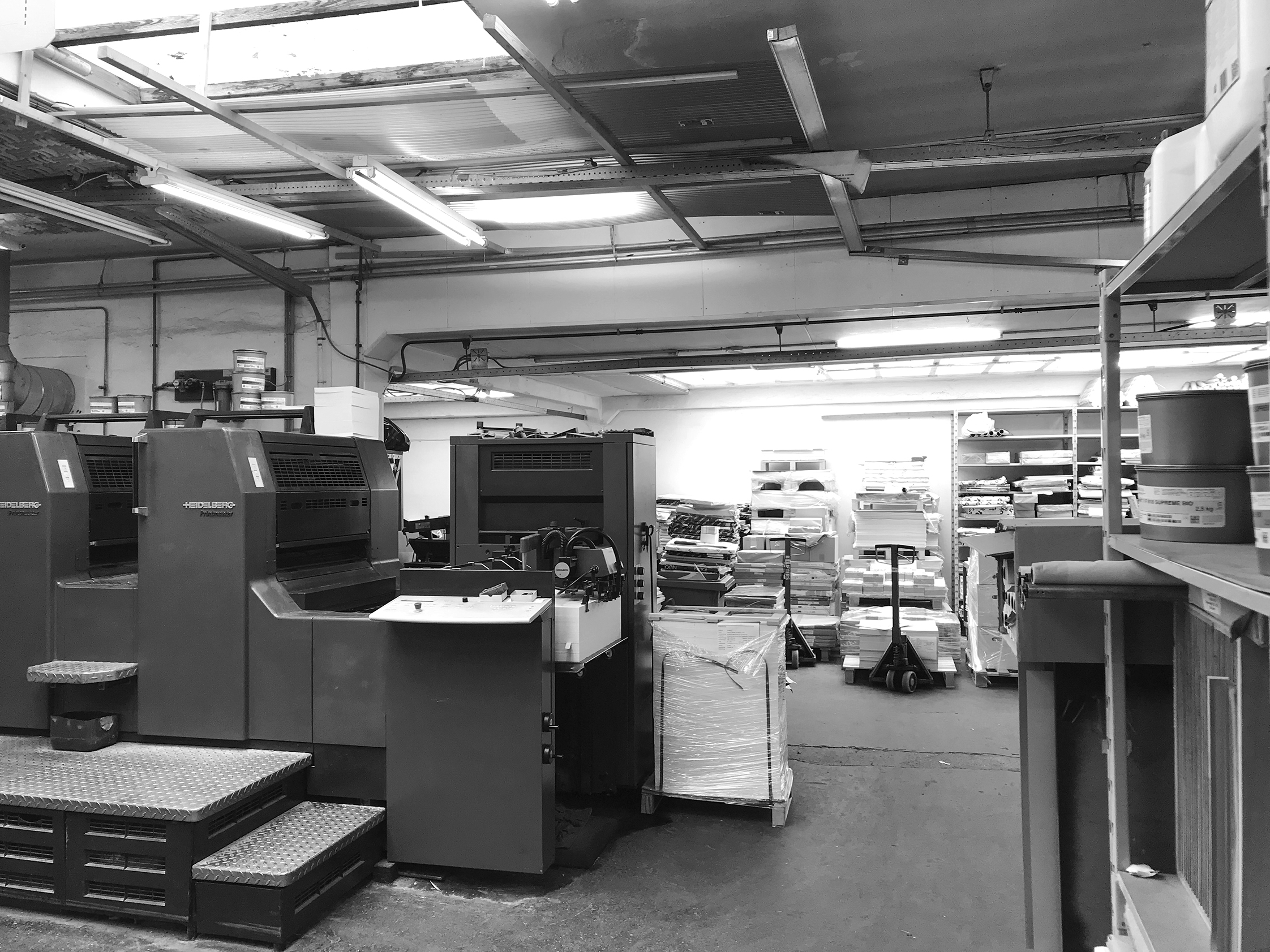
It was quite big group of people and often were not easy to comprehend because everyone wanted to express their opinion and sometimes finding common ground took time. Already while working on Bluf! Team was thinking how to be more professional and how to improve. After some time, Raddraaier’s members changed, some people left and new ones appeared. At the end of 1994, the team decided to make a next step and invested in offset printer. A loan in the bank was obtained and the printer was purchased same year. From there, the printing house has undergone transformations and become more professional and in 2018 Raddraaier won court case and got legal status and now it has status of legalized squat.
Being conscious citizens under surveillance
By describing the times of social control in Poland in the 1980s, I began to wonder about the role of the underground press and how important it was that it operated at that time in Poland. Is there a similar mechanism of surveillance of regime in Europe today? Currently the Internet is now one of the main control tools. At the beginning of its existence, the Internet was modelled and dreamt up as a free place where sharing information, music and views were not controlled by governments or any companies. It was a project of hope one could even argue, considering democratic values. At our present time the situation the world finds itself in regarding what Bratton calls The Stack is completely different.36 Manipulation of information, algorithms suggesting a search results in browsers, monitoring of email and social media accounts are on the agenda. Different companies are working on technologies and algorithms to harvest as much data as possible so that they can later be traded or manipulated. In recent years, for example British political consulting company - Cambridge Analytica was scanning millions of Facebook users without their knowledge and consent, collecting personal data for the purpose of political advertising.37 All steps we take in the internet are trackable and monitored by private companies and secret service.
he London based VOTR are activists of a radical environmental group who use their private press to express their opinions about surveillance of internet as a control tool and their concern towards fur farms, meat consumption and slaughterhouse as well as animals used for medical experiments. While writing thesis, I hoped that I could organize a meeting with some group members, but it did not succeed because it is quite a hermetic group and they were not too keen to meet. Through our mutual friend I was able to persuade them to chat on the phone. During our conversation they mentioned that they never use internet to communicate between each other.38] One of the group member called “Ana” said: When you use the internet, everything is monitored. Few years back, during my cultural studies I was searching for a lot of information about Islam, which I needed for my master’s thesis. Then all of the sudden I’ve received a call to report to the police station. I didn’t know what my call was about. When I came to the police station and they called me to the room where I met a man working for the secret services who aggressively asked me why am I is so interested in Islamic issues. To my surprise, he had printed my search results and my correspondence with various people. This experience opened my eyes that even with my research for diploma someone might watch me. I was quite surprised to be honest.
Members of VOTR described to me several actions they took to free animals from fur farms in various places in Europe. According to these activists, animals are prisoners and do not deserve to live in such bad conditions, and most importantly, to be imprisoned so their skin would be torn off and used as Clothes. They are happy to see that there are a more and more organizations trying to show cruelty towards animal in this farms and publicize it for a wider audience such as Otwarte Klatki (Open Cages).39 During the conversation, one of the group’s members - Adam described the activity of VOTR as follows: We don’t eat animals, don’t ride them and in general we would like all animals to be free in the nature. Our action may seem radical in eyes of authorities but for us that’s authorities and some people in our society who are radical. We also take a lot of security measures to not to be tracked. We don’t use the Oyster card when we travel, we don’t talk about our actions on the phone. Paper and things we need for print are bought by people that are not connected with us directly. We publish the quarterly “Front” in which we describe farms where animals are treated brutally or have particularly poor conditions, about our actions or to simply express our views about various related topics. The place of printing is known only to a few people.
Looking closer to the examples I’ve mentioned, it is worth noting, despite quite big range of time and various types of restrictions, that all these forms of activism have a common feature in form of creativity and determination to fight an oppression. In present time with help of internet and social media there are new ways in which activists are spread information with great speed and range. In July, 2017 a member of German activist from group called ZPS (Zentrum für Politische Schönheit - Center For Political Beauty) installed a remote-controlled printer in hotel room in Instanbil’s Gezi Park.40

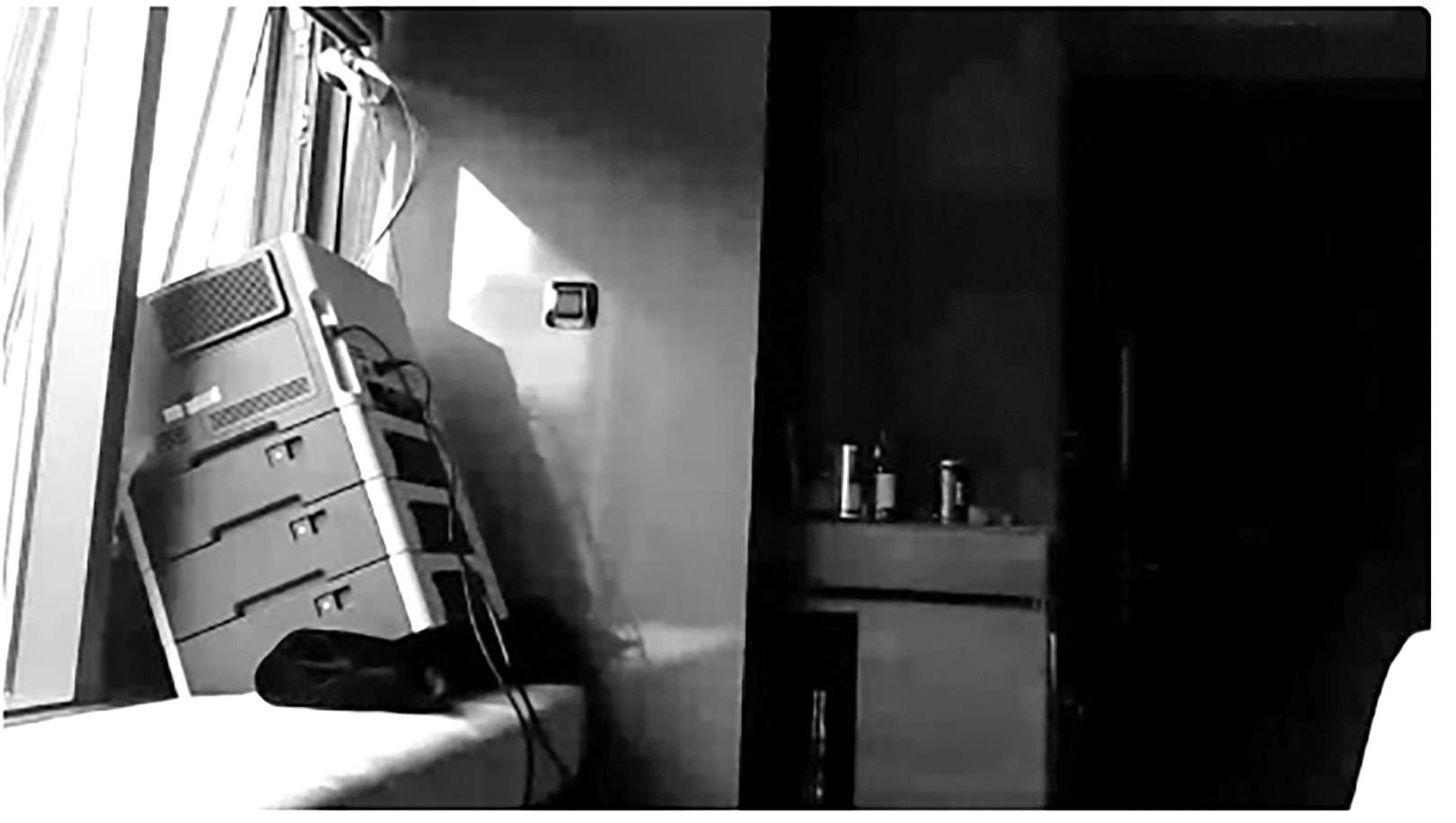
Printer was placed against the widow and when activist Marius E. (not confirmed if that’s his real name) left his room and arrived to airport activated the printer by using separate internet network in the room and application on his phone. The printer managed to print leaflets manifesto against the Turkish President Recep Tayyip Erdoğan. The leaflets says, among other things: “Don’t be a will-less herd of fellow travellers who allow neighbours to be killed or imprisoned.” “And:” Together we are stronger than any system. Death to the dictator!”41 Police took investigation really seriously and made a detailed examination in the room and launched a large scale investigation. Despite the generally accepted freedom of speech in Turkey, this incident exposes how threatened current Erdoğan government feels towards anti-government comments.
Before starting my research, I was not aware of the fact that private press really was a form of activism that had an indirect or direct impact on regimes and societies in various places around the world. The work on typographer and printer was an inseparable element characterizing these places. Through restrictions, imposed by the political situation, works that emerged from the private press had their specific quality and style. Visually the style of those works vary from from artistic as for example in the case of Kelmscott press to more chaotic and ruff like in case of Polish resistant prints. I was really impressed how, despite all the difficulties, people were able to organize and find together a way to fight oppression. A case of Brdzola newspaper in Georgia shows that it was one of the key elements influencing the Russian revolution at the beginning of communism. Sixty four years later in 1981 private press in Poland, on the other hand, shows the scale of determination to fight the communist regime where people, even in such extreme conditions as in internment camps, were able to resist it by writing poetry, songs or build a printer with a piece of glass and rubber and print anti-regime publications. Private press is a historical example of creative ways to fight the oppressing system. In present days we face new ever-changing forms of oppression, therefore, we need to respond with adequate solutions. However, as we know, history likes to repeat itself and the insights from the past might give us some clues and lead us to the new directions in how we could deal with the obstacles we are facing now.
Endnotes
1. Roderick C. (1971). The Private Press (1st edition). Watson-Guptill Publications.
2. Thomas and Geoffrey Handley-Taylor(1958).The book of Private Press. The Signet Press.
3. Norman Kelvin (1996), The Collected Letters of William Morris, Princeton University Press.
4. Phillippa Bennett (2008), A legacy Great Wonders: The last Romances of William Morris and the Kelmscott Press. Canadian Society for Aesthetics, Journal 15
5. Roderick C. (1971). The Private Press (1st edition). Watson-Guptill Publications.
6. www.itinari.com, Anano Chikhradze, Stalin's Underground Printing House — Feel the spirit of Soviet Georgia.
7. Stephen F. Jones (2005), Socialism in Georgian Colors: The European Road to Social Democracy, 1883-1917, Harvard University Press.
8. www.medium.com, Angelo Zinna, Inside Stalin's Secret Print House in Tbilisi, Georgia.
9. Katharina Stadler (2016), Counter-Signal 1, Other Forms, Chicago.
10. www.polskaprasa.cba.pl, Andrzej Kaczyński — Prasa podziemna.
11. www.wielka-solidarnosc.pl, Solidarność 1980 —1989, Lokalna prasa niezależna.
12. www.wielka-solidarnosc.pl, Solidarność 1980—1989, Lokalna prasa niezależna.
13. Jacek Okoń (1990), Twórczość artystyczna internowanych z Regionu Śląsko-Dąbrowskiego, Muzeum Górnictwa Węglowego w Zabrzu.
14. Z.Z. [monogram Zdzisława Zwoźniaka], Prasa w regionie w II połowie 1982 roku.
15. J. Jurkiewicz, Poza cenzurą. Poczta Internowanych (1981-1982).
16. www.bu.kul.pl, Anna Gabłońska, Czasopisma drugiego obiegu w zbiorach Bu Kul.
17. Tomasz Strzyżewski (2015), Wielka ksiega cenzury w PRL, Prohibita.
18. Szczepan Rudka (2001) , Poza cenzurą: wrocławska prasa bezdebitowa 1973-1989, Wydawnictwo Naukowe PWN.
19. Siobhan K. Doucette (2013), Mightier than the sword: Polish Independent Publishing, 1976-1989, Washington, DC.
20. Régis Debray (2007), Socialism: A Life-Cycle, New left review.
21. Counter signals #1 (2017), The politics of the joy of printing in Detroit, Other Forms, Chicago.
22. www.history.com, Civil Rights Movement, October 27, 2009.
23. Michael Hamlin (1970), The political thought of James Forman, Black Star, Detroit.
24. Dan Georgakas and Marvin Surkin’s (1975), Detroit: I do mind Dying. (1st edition), South End Press.
25. Danielle Aubert (2019), The Detroit Pronting Co-op, Inventory Press, LLC.
26. Lorraine Perlman (1989), Having Little, Being Much, Black & Red, Detroit.
27. American journalist A.J. Liebling, ARTZINES #12 (2019), Provo Special, Paris.
28. Adelita Husni-Bey (2017), White Paper: On land, law and the imaginary, Casco.
29. www.theculturetrip.com, A Brief History of Squatting in Amsterdam, Tom Coggins, 21 January 2017.
30. ARTZINES #12, Provo Special, Paris, 2018.
31. ARTZINES #12, Provo Special, Paris, 2018.
32. ARTZINES #12, Provo Special, Paris, 2018.
33. Jeugd en Samenleving (Youth and Society) (1991), article title: Je Bevrijden van de Drukpers” (To liberate yourself from the Printing Press).
34. Experimental Jetset (2011), Two or three things I know about Provo, Amsterdam.
35.From my own notes during the conversation with Cia Franssens, Amsterdam, 2019.
36. Benjamin Bratton, The Stack: On Software and Sovereignty, The MIT Press 2016.
37. www.theguardian.com, Revealed: 50 milion Facebook profiles harvested for Cambridge Analytica in major data breach. Carole Cadwalladr & Emma Graham-Harrison.
38. Personal conversation with VOTR members, November 2019.
39. www.otwarteklatki.pl, Takie są realia hodowli zwierząt na futro. Były pracownik fermy norek ujawnia drastyczny film. Asja Michnicka.
40. https://twitter.com/politicalbeauty
41. www.bento.de, "Tod dem Diktator": Werfen Deutsche Anti-Erdogan-Flugblätter in Istanbul ab? Marc Röhlig.